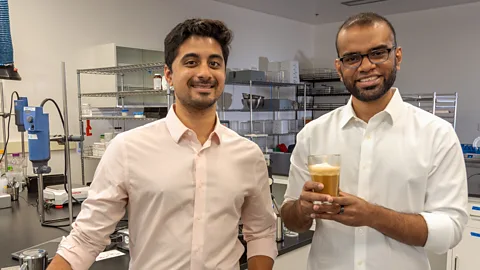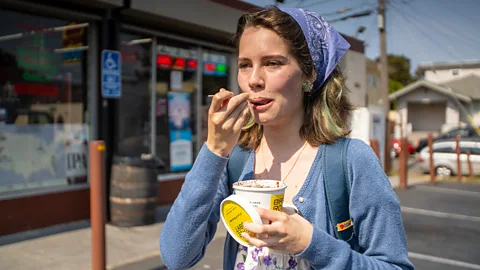By Jessica BrownFeatures correspondent
Raising livestock contributes a significant proportion of the food industry’s climate emissions, but scientists and a growing number of companies are hoping that growing meat – everything from beef to turkey and even fish – from cell cultures in laboratories may offer a solution.
The glass of froth-topped coffee being offered by Perumal Gandhi looks like any other latte you might enjoy during a morning stop at a café. Except, the milk in this cup did not come from a cow – it was produced by fungi.
Gandhi and his fellow bioengineer Ryan Pandya, who are the co-founders of a start-up called Perfect Day, equip fungi with gene sequences used by cows to produce certain milk proteins, such as whey protein. Rather than taking DNA from a cow, they use already-decoded genes for the milk proteins, and insert those genes into fungi. In a fermentation process, the fungi then produce the proteins. The resulting product can be used to create a liquid with similar properties to animal milk, or to make animal-free ice creams or cream cheeses.
It is one of a growing number of attempts to find alternative ways of producing food without using animals – known as cellular agriculture. The idea is to produce meat, milk or other animal products without needing to rear, slaughter and butcher livestock. Growing food this way could be kinder to the planet, too.
Livestock alone makes up around 14.5% of global greenhouse gas emissions. The food industry as a whole accounts for a third of our carbon emissions. Putting food into the mouths of billions of people every day is a monumental task and one that is likely to get even greater as human populations increase. From deforestation to transport, waste management to food storage, each step of the food chain brings with it a high carbon footprint.
If the world is to meet the ambition of reaching net zero carbon emissions by the middle of the century as outlined in the Paris Agreement on climate change, the food industry is going to have to play its part. How might the food we eat change as 2050 draws near?
Gandhi and Pandya, who are based in Berkley, California, hope they might be part of the solution. Other scientists around the world are similarly hoping to produce foods that imitate meat and dairy in the laboratory.

TurtleTree Labs in Singapore, for example, is the first company in the world to use stem cells from mammals to make milk, by encouraging the cells to produce milk in huge bioreactors. By reducing the need for dairy cows, it is hoped such solutions might also reduce the amount of methane – a potent greenhouse gas which traps up to 25 times more heat than CO2 during its first 100 years in the atmosphere – produced by the millions of cows worldwide as they digest their food. The company also says it could cut down on transport costs and emissions as the bioreactors could potentially be placed closer to where the milk is sold rather than on farms.
Similar technologies are also being used to create meat in the laboratory, by growing it from animal cells. In 2013, scientist Mark Post unveiled the world’s first lab-grown beef burger, formed from small bundles of muscle fibres made by culturing cells taken from a cow. He called his creation a “very good start”, and, true to his word, his company Mosa Meat can now create 80,000 burgers just from a sample of cells the size of a sesame seed. There are now a growing number of attempts to grow cellular meat from different animals, including lamb, pork, fish and chicken – which was last year approved for sale in Singapore.
2045: Memories of the Future
This article is part of 2045: Memories of the Future, a multimedia series by BBC Future and BBC World News that examines how much the world will have to change by the year 2045 if it is to reach net zero by the middle of the Century and so keep climate change to within the 1.5C target set by the Paris Agreement on Climate Change.
There are significant barriers, however, to getting cell-based milk, and meat, into the market. Meeting food standards isn’t easy when you’re dealing with new foods and neither is scaling up the complex production needed from a laboratory to the levels needed to provide a reliable source of food to supermarkets and shops. There will also be challenges balancing the costs associated with the technologies involved in producing something currently on such a small scale. However, experts say cell-based meat can be produced at the same cost as conventional meat once it has scaled up.
Provided those technical difficulties can be overcome, people seem to be willing to eat lab-grown food. One recent study of consumers in the UK estimated that cultured meat could make up to 40% of the UK’s annual meat intake, based on public willingness to try lab-grown products.
But there are other innovations being developed by researchers that could also help to reduce emissions from the food we eat.
Scientists in New Zealand, for example, are researching a vaccine that can be given to sheep and cows to reduce the amount of methane gas they produce. Regenerative agriculture, which aims to improve the health of soil by using practices that disturb the soil less, allowing soil’s organic matter to regenerate, and rotating crops so the soil retains a diverse range of nutrients. Soil can act as a carbon sink as plant matter decomposes and becomes locked away in the earth. But if the soil is disturbed by excessive tilling, for example, that carbon can be released back into the atmosphere.

 Nicholas Yeo/AFP/Getty Images
Nicholas Yeo/AFP/Getty ImagesThe UK-based project, AgriCaptureCO2, is also developing a way to measure the carbon captured in soil, using satellite images, farmers’ data and soil samples. The aim is for farmers to be able to track their efforts to put more carbon in the ground.
Another major innovation in farming in recent years has been vertical farming. Instead of sunlight, plants in indoor farms are fed light of specific wavelengths from LEDs, while their needs for water and nutrients are monitored by technology. Vertical farms can grow crops much faster than fields can, but they also use up a lot of energy for lighting and heating, says Fiona Burnett, professor of applied plant pathology at Scotland’s Rural College.
This, she says, means that they’re only really cost-effective in areas of the world where climates are so extreme that it’s difficult to grow crops with traditional farming methods, or so remote it’s difficult to get food to people. At the moment, vertical farms have a high CO2 output, but emerging technologies aim to lower this, including drawing energy from ground sources, using batteries to store energy from renewable energy sources, and using particular wavelengths instead of white light to accelerate growth.
Vertical farming will also need to find its place in the global supply chain to supply the right kind of food that needs growing, Burnett says.
“You have a lot of innovator companies in this space who are competing. At the moment they’re separate from traditional farmers, but there’s a lot of potential to join up and be better linked into the food supply. This will have to happen.”
But while high-tech solutions like this could help to reduce the carbon footprint of farming, it may also require some changes in consumer behaviour.
“At the turn of the century, we were growing enough calories to feed 10 to 12 billion people, but we only had seven billion people on the planet,” says Tim Benton, director of Chatham House’s environment and society programme. “It’s been about producing more, eating more, throwing more away and making it cheaper”
Now, we must change what we eat to change the food system, he says.
An estimated 17% of food grown around the world in 2019 was wasted at various points in the food chain, amounting to 931 million tonnes. At least 61% came from households, according to the Food and Agriculture Organization, while the rest occurring during harvesting, transport, processing and retail. Not only does this mean the carbon released while producing the food is also essentially wasted, but as the food rots, it releases more greenhouse gases into the atmosphere. In the UK alone, food waste in 2018 was responsible for around 36 million tonnes of greenhouse gases.
While efforts to reduce food waste with better storage, refrigeration and transport methods could help to cut emissions, other changes are needed to ensure as much edible produce as possible is being used. This could also help to make food more accessible elsewhere, especially when it is donated to food banks and other social and charitable efforts.


But it could mean some fundamental changes to our relationship with food too, says Benton.
“If we reduce demand enough, we don’t have to have very intensive farming, we don’t have to use a lot of chemicals, we don’t have to destroy biodiversity,” he says.
Ultimately, Benton says, the whole food system needs to change, including how we think about, package and transport food, how we regulate it and trade it.
“It’s not a silver bullet. The whole innovation architecture and the innovation of governance systems is really important to get the whole food system to transform into a low carbon emissions system,” he says.
—
Join one million Future fans by liking us on Facebook, or follow us on Twitter or Instagram.
If you liked this story, sign up for the weekly bbc.com features newsletter, called “The Essential List” – a handpicked selection of stories from BBC Future, Culture, Worklife, Travel and Reel delivered to your inbox every Friday.
Credit: Source link



